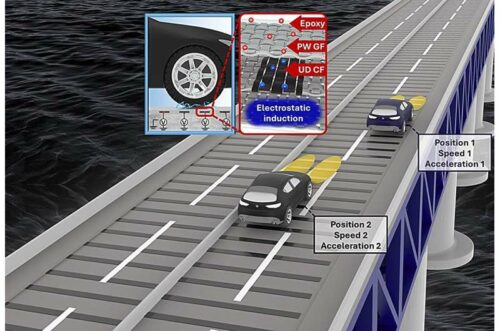The carbon fiber sensors monitor traffic and road conditions in real-time, generate electrical energy, and enhance structural health monitoring.

A research team affiliated with UNIST has achieved a breakthrough in traffic monitoring technology by unveiling advanced sensors made from carbon fiber composites. These sensors can monitor traffic and road conditions in real-time while also strengthening buildings and road structures. They enable applications such as traffic condition monitoring, traffic accident detection, and traffic accident prediction through real-time tracking of vehicle position, speed, and acceleration.
Experimental results revealed that the FRP, composed of carbon fibers, glass fibers, and epoxy, generated electrical energy as tires passed over it. Remarkably, even after subjecting the FRP-TES grid to 10,000 tire passes, no discernible voltage degradation was observed, and its mechanical properties exceeded those of conventional TES systems. Carbon fiber composites offer excellent mechanical properties, weighing about a quarter as much as iron while possessing ten times greater strength. These advantages make them ideal for widespread use in various applications, surpassing traditional iron-based materials.
Experimental results revealed that the FRP, composed of carbon fibers, glass fibers, and epoxy, generated electrical energy as tires passed over it. Remarkably, even after subjecting the FRP-TES grid to 10,000 tire passes, no discernible voltage degradation was observed, and its mechanical properties exceeded those of conventional TES systems. Carbon fiber composites offer excellent mechanical properties, weighing about a quarter as much as iron while possessing ten times greater strength. These advantages make them suitable for widespread use in various applications, surpassing traditional iron-based materials.
Future research will focus on integrating the triboelectric mechanism of FRP with Structural Health Monitoring (SHM) using carbon fiber. This integration aims to develop intelligent infrastructure capable of both traffic monitoring and structural health monitoring.







